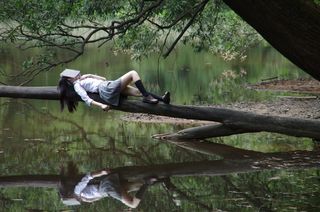Loneliness
Being Alone vs. Being Lonely
What are you going to do today to beat loneliness?
Posted April 16, 2020 Reviewed by Jessica Schrader
And the people stayed home. And read books, and listened, and rested, and exercised, and made art, and played games, and learned new ways of being, and were still. And listened more deeply. Some meditated, some prayed, some danced. Some met their shadows. And the people began to think differently.
And the people healed. And, in the absence of people living in ignorant, dangerous, mindless, and heartless ways, the earth began to heal.
And when the danger passed, and the people joined together again, they grieved their losses, and made new choices, and dreamed new images, and created new ways to live and heal the earth fully, as they had been healed. –Kitty O'Meara

In the time we live in, with everything going on around us (post written during the 2020 pandemic), we need to make a clear dissociation between being alone and being lonely. It would be easy to mix those two, to cluster them together and perceive them in the same way. Common misperception. Being alone is the physical state of not being with another individual, might it be human or animal (I don’t think you are ‘alone’ if you have a cat/dog pet with you, or any pet requiring daily care/interaction). Being lonely is a psychological state characterised by a distressing experience occurring when one’s social relationships are (self-)perceived to be less in quantity and quality than desired. So, when the social contact you have at a given time does not fulfill you. Now, do you see the difference? Someone can be alone but not lonely and someone can feel lonely even when surrounded by people.
As we are riding the pandemic, social isolation and quarantine are required to help prevent diffusion of the virus (apparition of new cases of people infected by the virus) and help flatten the curve. What does “flattening the curve” mean exactly though? It has to do with trying to spread the number of people infected by the virus through time. It is the acknowledgment that people are going to get sick, but we can try to lower the total number of people getting sick. We can also try to make sure not everybody will be sick and in need of medical care at the same time, hence spreading through time to take into account the physical resources available in a country, especially in terms of the number of health care personnel. Doing that would reduce the stress put onto health care systems worldwide, allowing carers to provide assistance to more people without having to make some of the harsh-yet-needed decisions they currently have to take in some countries (knowing you only have space for one person, do you save the 70-year-old or the 50-year-old?). Can we really say that physical isolation is such a high price to pay?
We can all agree that it is not a fun thing to do, to self-isolate. Humans are a very social species: all our lives are built around a certain amount of social interactions and physical proximity. Even the most introverted of us could enjoy a limited amount of social contact … that has now been denied us. Being socially isolated is detrimental to our health, and not just our mental health. Long-term feelings of loneliness can have the same impact on your body than smoking or obesity. Moreover, extended social isolation can lead to post-traumatic stress disorder, anxiety, addiction, fear, and a few more unpleasant things. And that’s why it is quite important to not fall for the pitch fall of associating being alone and being lonely. We are going to spend a lot of time alone in the coming days (weeks? months?), how about we try to make the most of it?
The 21st century has brought many things, good and bad. But the main thing it has given us is the possibility to be remotely connected and cultivate social interactions in the absence of physical proximity. The older generations say the young ones are addicted to their phone and all that technology. What if it was a good thing nowadays? What if the problem was not in how much we use social media, but how we use them (or what we use them for)? Recent research has shown that this is the key element and the difference between being alone and lonely and being alone and connected. There are quite a few options for people to remain connected without physical contact. The first one being ... video chats! One of the things we miss most when deprived of social interactions is not necessarily the sound of someone else’s voice, but facial cues, body language and non-verbal communication in general. The thing you can see but not hear. The little thing that strengthens our bonds with others. Spending time next to someone, physically or virtually, is enough for us to feel connected. All hail virtual happy hours and connected dinners!

If the self-isolation period brings a lot of negatives, the one positive aspect is the amount of time some people will have. Working from home is still very much working. However, while keeping a routine is important, the amount of time spent on getting ready is bound to be much lower and we gain the time we would have used to commute to work. Those gained moments could be used not only to reach out to people, checking on them, and scrolling through your social media, but also to create a meaningful connection. Instead of just like a photo from a friend, you could send them a message and reach out directly, making it personal and making them feel special. Alternatively, you could use this new time to explore new social circles by trying to connect with people that share your passion or interest. If you have kids, connect with other parents having to entertain their children all day long, you’ll feel less alone and you might even get a few tips on how to get through the day. Find a group that represents you.

Another way for you to use this time (or something to include in your daily/weekly routine) is to exercise. It doesn’t have to be hard; it doesn’t have to be for a super long time, but it has to be something. For the people that can still leave their house—go and enjoy a walk! Get some air, freshen up your brain. For those on “house arrest,” there are plenty of videos and workouts out there, for every fitness level, requiring or not equipment (bodyweight is enough), that will help you get moving. Otherwise, you can always transform your living room into a dance floor and practice your moves without fear of judgment. Physical activity will not only help pass time, it will also put a smile on your face (or at least increase your level of feel-good hormones) while protecting your brain against aging by reinforcing connectivity between different areas. And it can help you sleep but tiring your body. There is always that.
Finally, you could use this time … to do nothing. Yup, that’s right, just sit down, in silence, and relax. Some people could call it meditating. Some people could say they are “reconnecting with themselves." Others say they are “checking in." Call it whatever you want but I would recommend doing it at least once a week (technically, the pile of evidence gathered from scientific studies recommends it). Before you start wondering if I’ve completely lost my mind by suggesting you isolate even more self-isolation, listen up (well, read up). We are surrounded by noise, all day long. Our senses are stimulated at all times. Even during our sleep, our ears are still perceiving the sounds around us, which in turn can affect the quality of our sleep (the quieter the place, the better your sleep). Creating silence around us, acoustic silence, but also attentional silence (when we stop looking for stimulation and shut ourselves from the world) and finally, physical silence (by the absence of movement, remaining still or walking slowly), can be extremely beneficial. Our brain does not shut down in those silent times, on the contrary: our thoughts wander, we daydream and listen to our inner thoughts, and our brain uses this time to remove all the waste created during the day (your brain is like a car engine, the more you use it, the more it “pollutes” or produces waste). This form of silence is about shifting your attention from the outside world towards the inside of your body and your mind. This silent state brings a calmness that allows your body and your mind to recharge. Meditating is not about (or not only about) anchoring yourself in the present time; it should be about creating the headspace for your thoughts to drift away, focus on your breathing as a way to stimulate the wander. Which in turn can make you more creative and develop your instincts.
Being alone is a chance for you to refocus on yourself, on your needs, on what makes you feel good. It is a time to use to identify which people you want to connect with, what hobbies you want to pick up. It is a chance to do all the things you never have time to do around the house. See this alone time as a chance to get to know yourself … and exercise (at least a bit).


